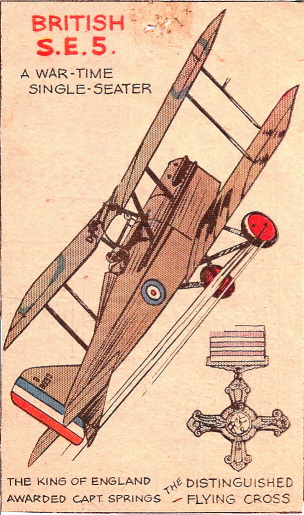S.E. 5a
British Fighter of World War One
By Stephen Sherman, Aug. 2001. Updated April 16, 2012.
Flown by the greatest Allied aces during the First World War - such as Billy Bishop, James McCudden and Edward Mannock, the Royal Aircraft Factory S.E.5 (Scout Experimental #5) was without doubt the most successful plane produced by this firm.
A single-seat biplane with dihedral wings, H.P. Folland's design team focused on making it easy to fly. This characteristic enabled the Royal Flying Corps to entrust the plane to relatively inexperienced pilots. Thanks to the efforts of the engineers, this aircraft was as almost as manoeuverable as its contemporary, the Sopwith Camel, but was noticeably faster and quieter.
Powered by a 150 HP (112 kw) Hispano-Suiza V; the SE.5 entered service on the Western Front in April 1917. The adoption of a more powerful engine, a 200 HP (149 kw) Hispano-Suiza, led to the SE 5a version, which otherwise offered only a few differences from the SE.5. The first examples of the new model appeared in the mid-1917 and replaced the SE.5 gradually. Undoubtedly the SE 5a was handicapped at this time by the unreliability of its engine and by the limited effectiveness of Constantinesco synchronizing gear. It was the first Allied scout with 2 machine guns: a Lewis gun on a Foster-mount on the top wing, and a side-mounted Vickers gun in front of the cockpit.
As soon as these problems had been resolved, the British biplane became a fighter with formidable capabilities. Toward the end of the War, some SE 5a's were employed in close support missions, armed with light bombs. The combined production of the SE.5 and the SE5a reached 5,205, including some modified as two-seaters.
Use
The SE 5 arrived at the Front with No. 56 Squadron in April, 1917, "Bloody April." In June, the improved S.E.5a was delivered to the squadron, which was withdrawn briefly to the Home Front to cope with the Gotha menace. By early summer, No. 15 Squadron was also equipped. By Winter 1917-18, Nos. 24, 32, 64 Squadrons also received SE5a's.
The plane was used in Egypt, Mesopotamia, and Palestine, and also on the Salonica Front. Many were assigned to the air defense of British territory, with unimpressive results.
American aces who flew the SE 5a included: Hilbert Leigh Bair, Louis Bennett, Jr., Charles A. Bissonette, Sydney M. Brown, Alvin A. Callander, John O. Donaldson, John S. Griffith, Frank A. Hale, Duerson Knight, Howard Kullberg, Willaim C. Lambert, Jens F. Larsen, Reed G. Landis, Frederick E. Luff, Frances P. Magoun, Bogart Rogers, Oren J. Rose, and Harold G. Shoemaker.
The S.E. 5a was also employed by American military aviation. Plans for manufacture for the US Army, under license by Curtiss Aeroplane and Motor Company, were drawn up. The cessation of hostilities, in November 1918, ended these projects. Only one example was built by Curtiss, which accepted moreover the components needed to assemble 56 more units coming from Great Britain. Another batch was produced after the war by Eberhart Steel Products, in the United States.
Characteristics - Royal Aircraft Factory SE 5a
Type: single-seat pursuit plane (Great Britain)
Engine: Hispano-Suiza, 8 cylinders V, 200 HP (149 kw)
Performance: maximum speed - 220 km/h; practical ceiling - 6705
m; endurance - 3 hours
Weight: empty - 635 kg; maximum on takeoff - 887 kg
Dimensions: wingspan - 8.12 m; length - 6.38 m; height - 2.90 m
Armament: forward-facing, synchronized 7.7mm Vickers
machine-gun, and Lewis gun installed atop the center of the upper wing;
four 18 kg. bombs.


